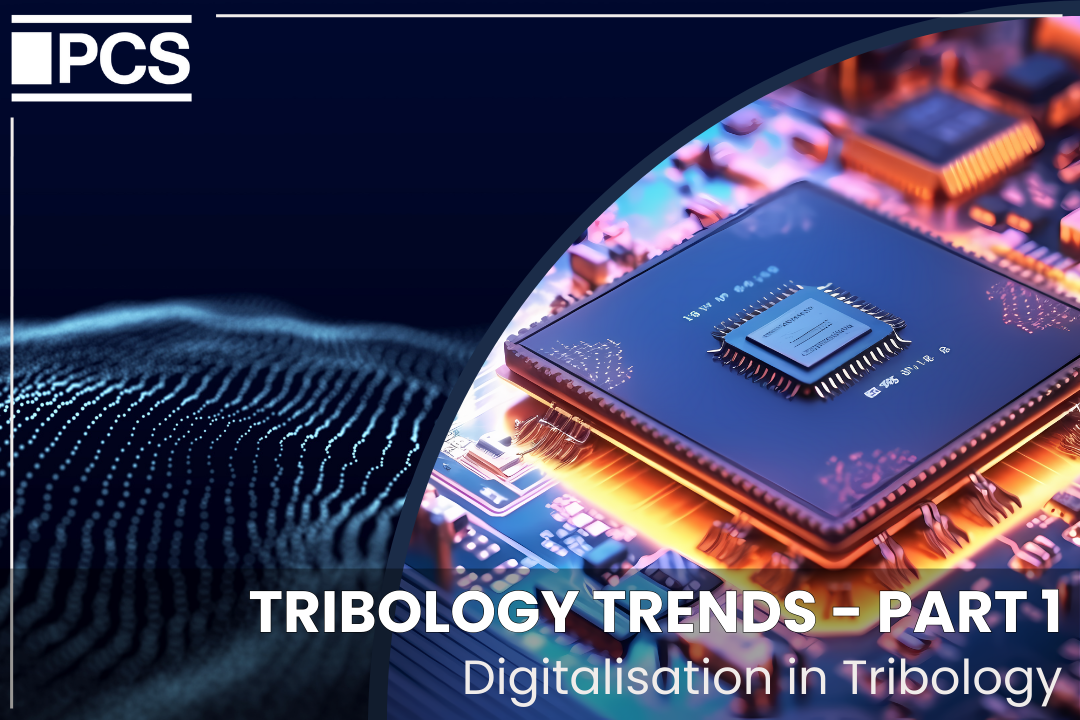Tribology Trends

Part 1 – Digitalisation in Tribology
In the ever-evolving landscape of modern industry, the convergence of Industry 4.0, digitalisation, and tribology is ushering in transformative changes across manufacturing processes. This article, the first instalment of our series exploring emerging tribological trends, focuses on the emergence of digitalisation in tribology and its profound implications for industrial efficiency and sustainability. As manufacturing sectors continue to evolve within the framework of Industry 4.0, the integration of digital technologies with tribological principles offers novel opportunities to optimise mechanical systems by reducing friction, minimising wear, and enhancing overall performance through advanced lubrication strategies. Join us as we delve deeper into this pivotal trend and its implications for the future of manufacturing.
What is Digitalisation in Tribology?

Digitalisation in tribology represents the fusion of digital technologies with tribological principles to enhance friction management and surface interactions in mechanical systems [1]. Essentially, digital tribology leverages advanced computational methods and data-driven insights to bolster the performance and reliability of industrial processes. By incorporating digital tools into manufacturing, industries can establish “smart factories” characterised by interconnected systems and intelligent automation. This amalgamation of technologies holds immense promise for revolutionising traditional industrial processes, offering unprecedented opportunities for performance enhancement and efficiency improvement [1].
Why is it Important?
When it comes to tribology, diving into the digital realm is a game-changer. It’s not just about adopting technology; it’s about leveraging it to gain deep insights into mechanical systems, guiding us towards smarter decisions and better performance. This proactive approach to maintenance and efficiency isn’t just a trend; it’s the key to reducing downtime, prolonging equipment lifespan, and staying competitive in the global market [1].
Industry Applications
Streamlining Tribological Advancements
Digital twin technology enables real-time monitoring, simulation, and optimisation of mechanical systems, allowing for accurate prediction of wear and performance degradation. Manufacturers, particularly in the automotive sector, can utilise digital twin technology to simulate various operating conditions virtually before implementing changes in the physical realm, leading to fine-tuned lubrication strategies and early detection of potential issues [1].

Integrating Condition Monitoring Seamlessly
The intersection of digitalisation and tribology is particularly evident in condition monitoring and predictive maintenance. IoT-enabled sensors gather real-time data on crucial parameters, enabling advanced analytics to detect early signs of wear or impending failures. Predictive maintenance strategies based on this data analysis enable proactive interventions, thereby reducing downtime and maintenance costs, especially in industries like manufacturing and energy production. For instance, in manufacturing plants, condition monitoring sensors offer continuous assessments of machinery health, allowing maintenance teams to schedule repairs before equipment failures occur, thus preventing costly downtime [1].
Advancing Production with Additive Manufacturing
Integrating 3D printing technology and virtual models of machinery and components significantly expedites development and enhances efficiency. This innovative approach allows for precise creation of intricate geometries and customised components, leading to a transformation of conventional manufacturing methods across industries such as aerospace, automotive, and healthcare. As an example, in aerospace manufacturing, additive manufacturing techniques can be used to create lightweight, high-strength components with complex geometries, improving fuel efficiency and performance of aircraft [1].

Prioritising Sustainability in Tribology
Sustainability isn’t just a buzzword anymore; it’s a must for industries worldwide and tribology has a big role to play. Integrating digital tools and techniques into tribological practices means development of eco-friendly lubricants, reduction of frictional losses, and extending component lifespans. Manufacturers can minimise their environmental footprint while simultaneously maximising efficiency and profitability. It’s not just about doing business; it’s about doing business responsibly. For instance, in the renewable energy sector, digitalisation in tribology can lead to the development of more efficient wind turbine bearings, reducing maintenance requirements and increasing the overall sustainability of wind energy generation [1].
Challenges
Based on the insights from The Use of Artificial Intelligence in Tribology—A Perspective by Rosenkranz et al., the challenges associated with the implementation of digitalisation in tribology can be explored:
- Algorithm Accuracy: The accuracy of predictive maintenance algorithms, particularly those leveraging artificial neural networks (ANNs), is crucial for effective condition monitoring and performance prediction [1]. Ensuring that these algorithms accurately predict equipment failures requires robust data collection, precise modelling, and continuous validation against real-world performance data. Challenges may arise in fine-tuning these algorithms to account for diverse operating conditions and system complexities, requiring ongoing refinement and adaptation.
- Biases in Data Sets: Machine learning algorithms, including ANNs (Artificial Neural Network), may produce biased recommendations if trained on incomplete or unrepresentative data sets [1]. Addressing biases in data sets requires careful curation of training data, transparent model development, and ongoing evaluation of model performance across diverse scenarios. Furthermore, ensuring the diversity and representativeness of data inputs is essential for developing unbiased predictive models.
- Ethical Implications: The use of digitalisation technologies, particularly AI and machine learning, raises ethical concerns regarding privacy, data security, and algorithmic transparency [1]. Protecting sensitive information, ensuring consent and transparency in data usage, and implementing robust cybersecurity measures are paramount to maintaining trust and compliance with regulatory standards. Additionally, addressing ethical considerations such as algorithmic fairness and accountability is essential for responsible implementation of digitalisation in tribology.
- Implementation Hurdles: Integrating digitalisation solutions, such as predictive maintenance algorithms and condition monitoring systems, with existing equipment and workflows can pose compatibility issues and resistance from frontline workers [1]. Overcoming these hurdles necessitates comprehensive change management strategies, targeted training programs, and ongoing stakeholder engagement to foster acceptance and adoption of new technologies. Furthermore, ensuring seamless integration with legacy systems and addressing user concerns about job displacement are critical for successful implementation.
By addressing these challenges, industries can unlock the full potential of digitalisation in tribology, leveraging advanced technologies to enhance efficiency, reliability, and sustainability in manufacturing processes. However, proactive measures must be taken to mitigate risks and address ethical considerations, ensuring that the benefits of digitalisation are realised while safeguarding against potential pitfalls.
To sum up
The emergence of digitalisation in tribology signifies a pivotal shift in industrial practices, offering proactive solutions to long-standing challenges. By embracing advanced digital tools, industries stand to streamline processes, minimise downtime, and enhance overall performance, thereby paving the way for a more sustainable future. However, it’s crucial for industries to address key challenges head-on. Through focused efforts, industries can fully capitalise on digitalisation in tribology, ensuring its widespread adoption and reaping its numerous benefits across sectors. Commitment to leveraging digitalisation should drive positive change and propel industrial progress toward greater efficiency, reliability, and sustainability.
References
[1] A. Rosenkranz et al., “The Use of Artificial Intelligence in Tribology—A Perspective,” Lubricants, vol. 9, no. 1, p. 2, 2021. Available online: https://dx.doi.org/10.3390/lubricants9010002
To stay updated with the newest industry insights through our articles and news, click here!
